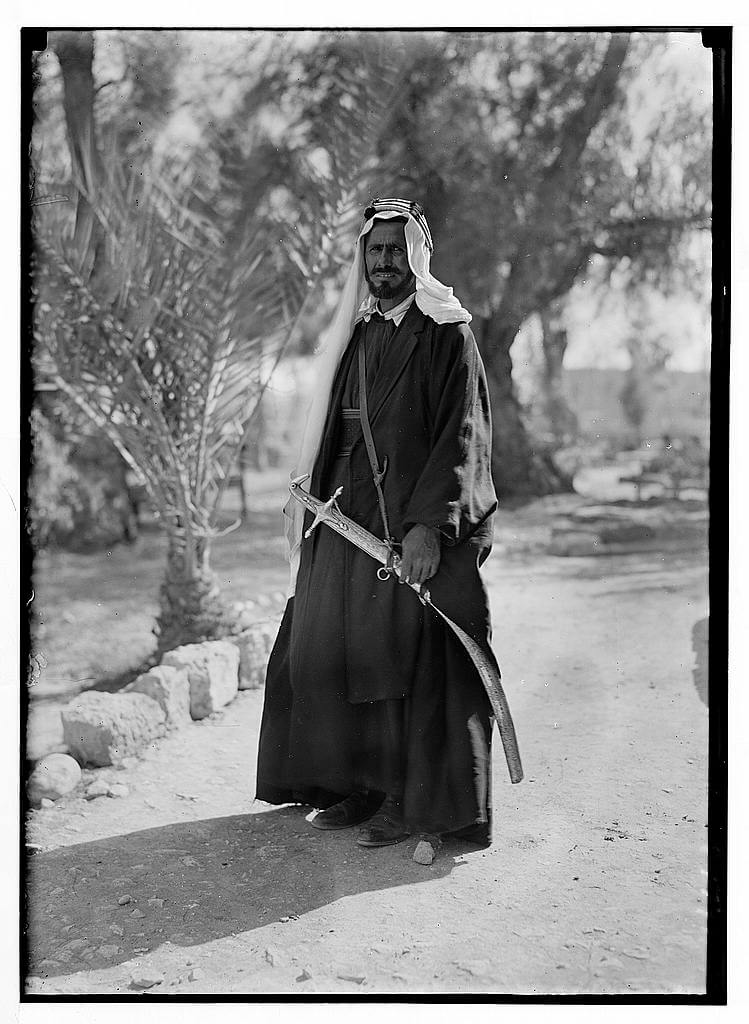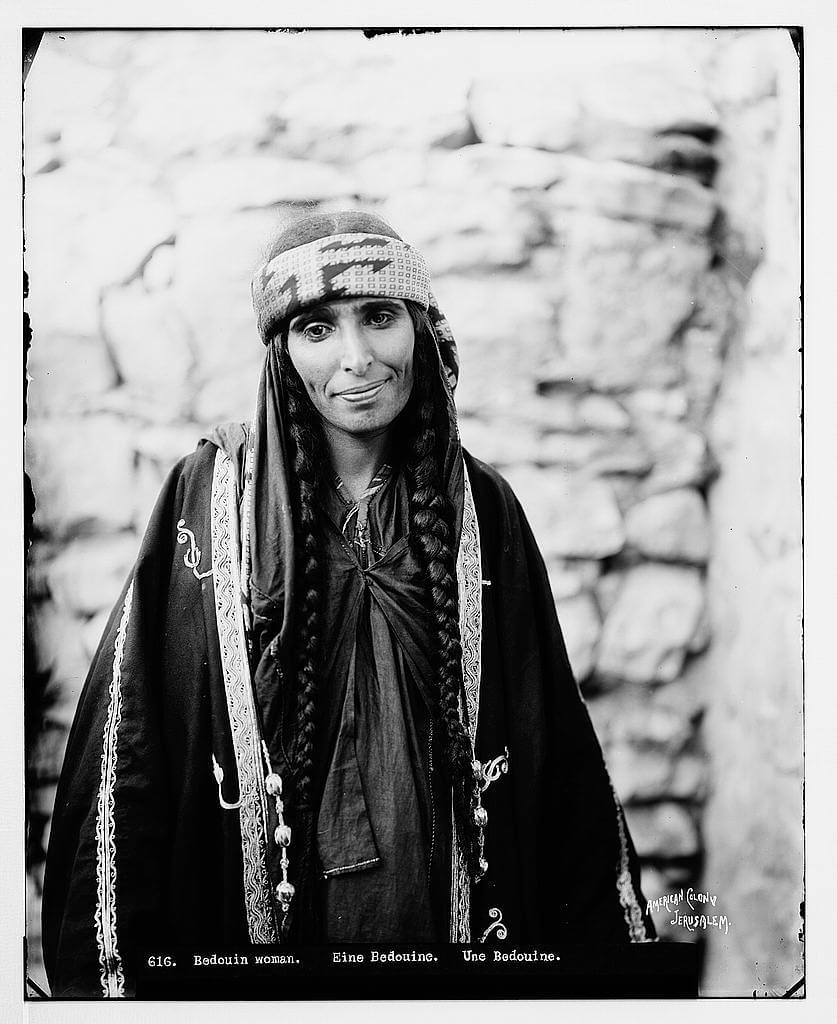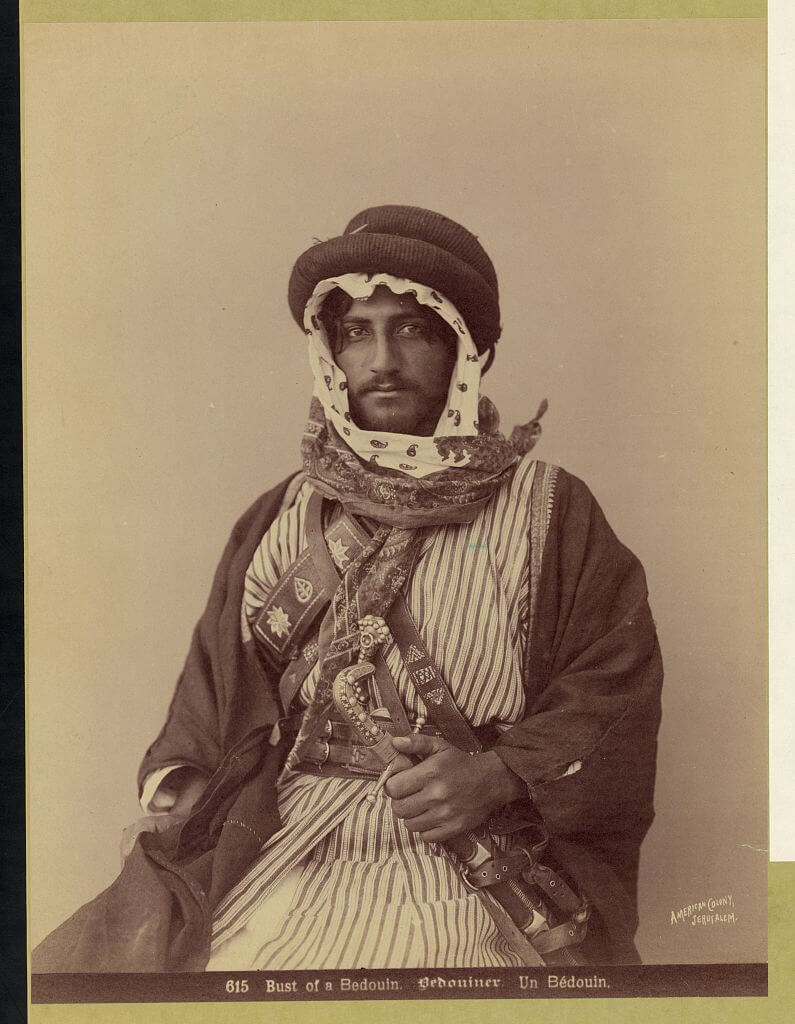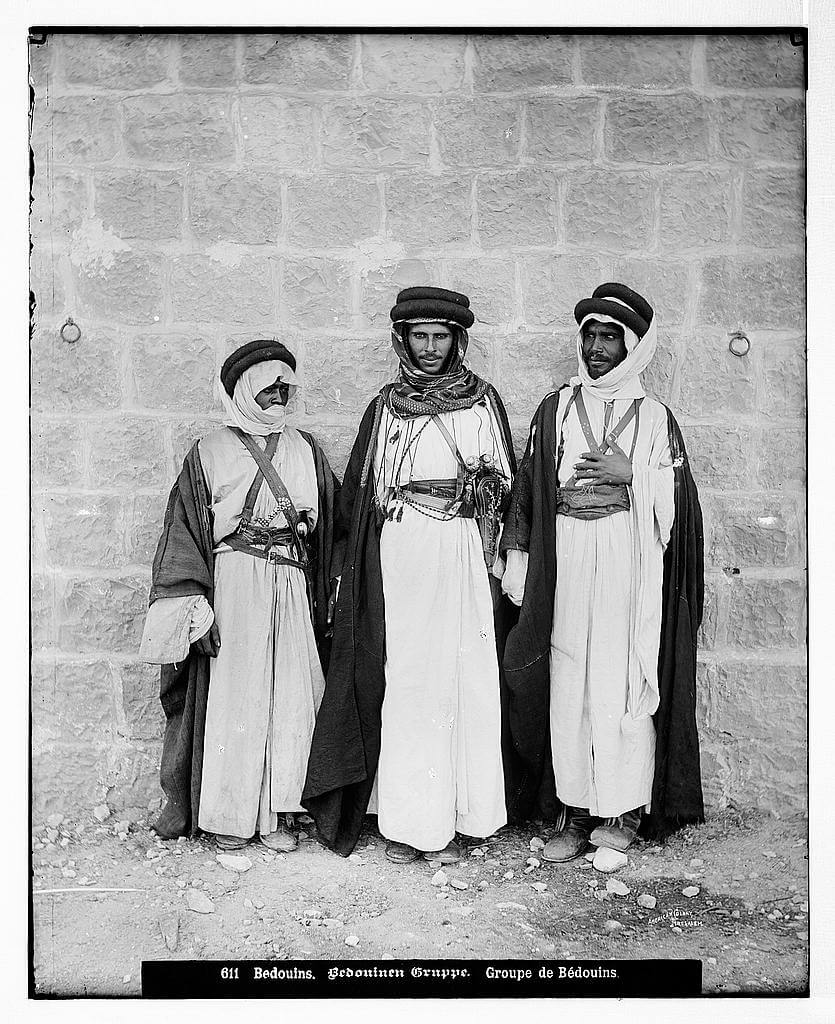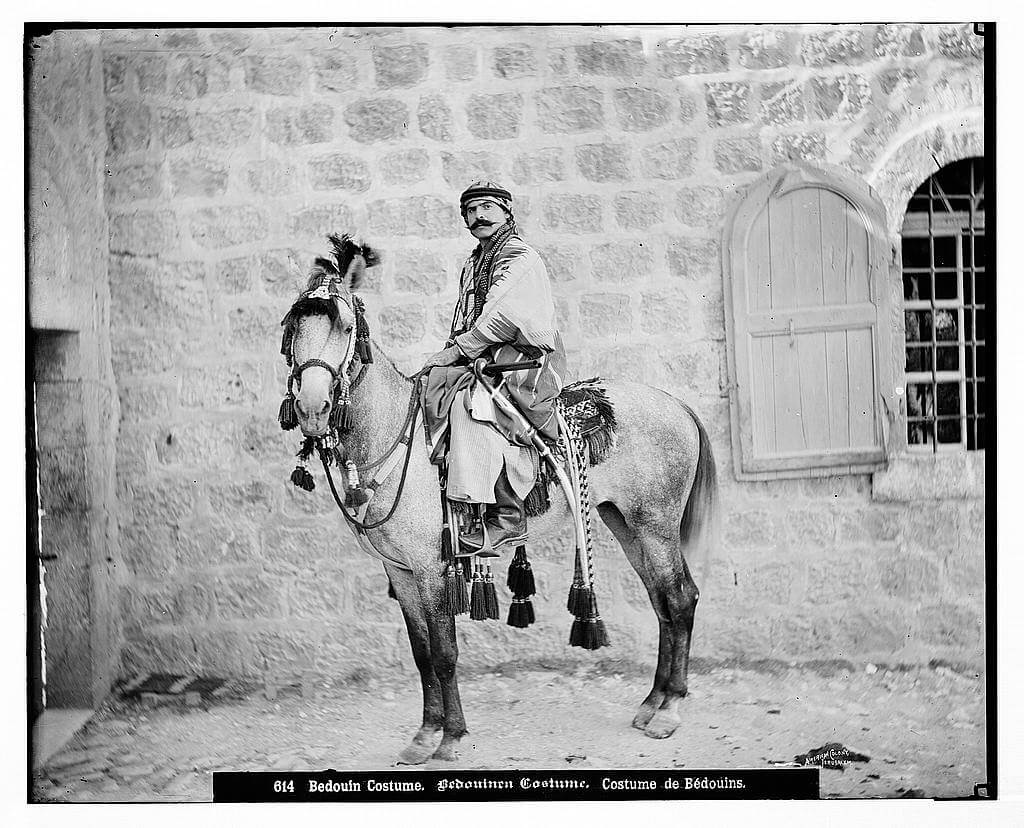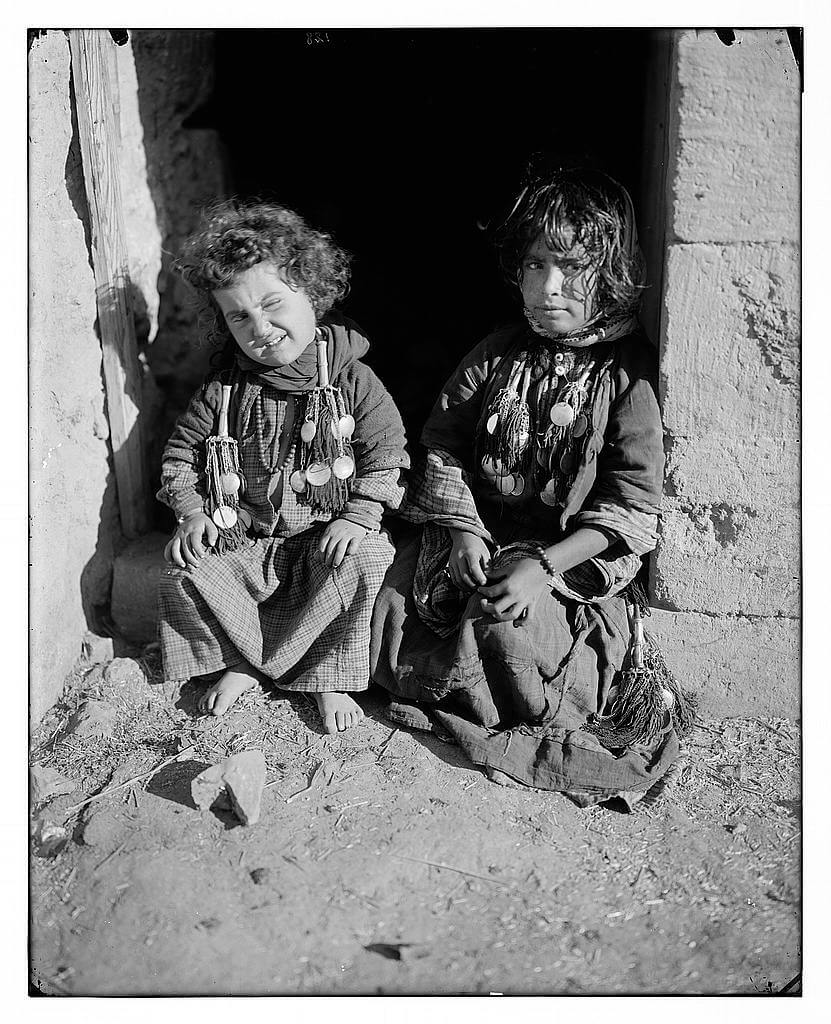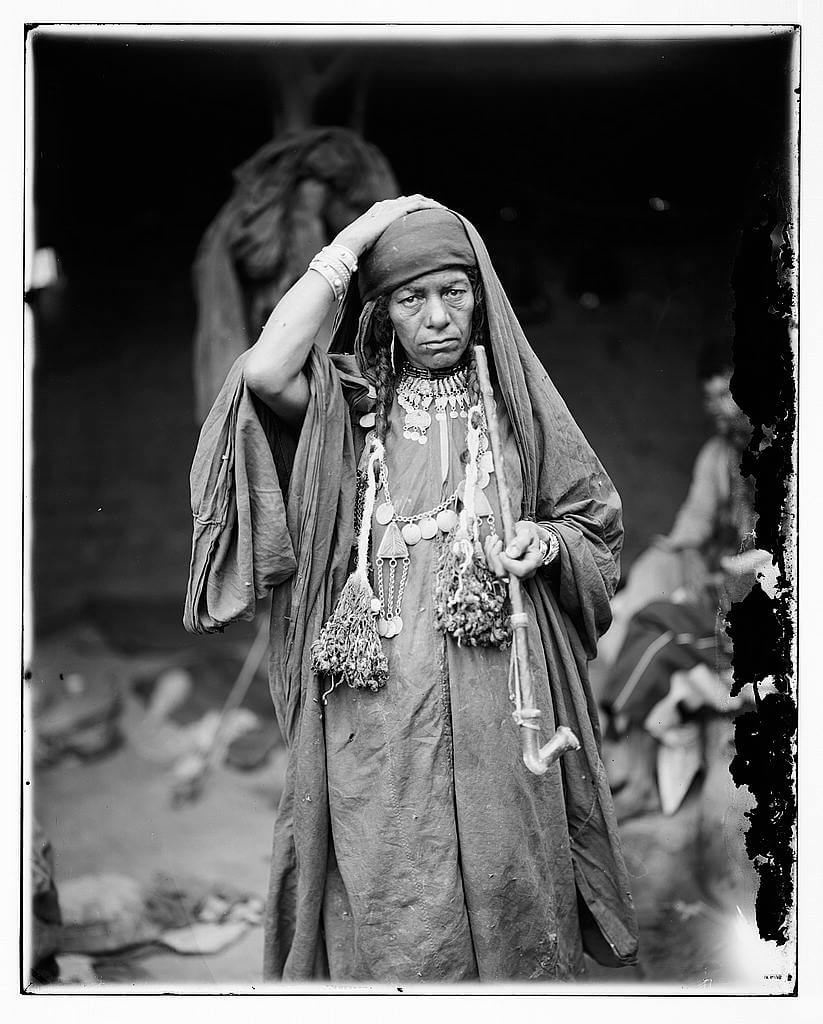At the turn of the 19th century, a group of utopian Christians moved from the United States and Sweden to Jerusalem, where they started a self-sufficient community called the American Colony. Unexpectedly, this community also ended up being highly influential as photographers in the Middle East in the early 20th century.
It might seem strange, but it’s true. From 1898 to 1946, a handful of utopian Christians took over 13,000 photos of important events, scenes, and people in the Middle East, especially around Palestine.
Nine girls standing over young boy holding sword and dressed in traditional Bedouin clothing
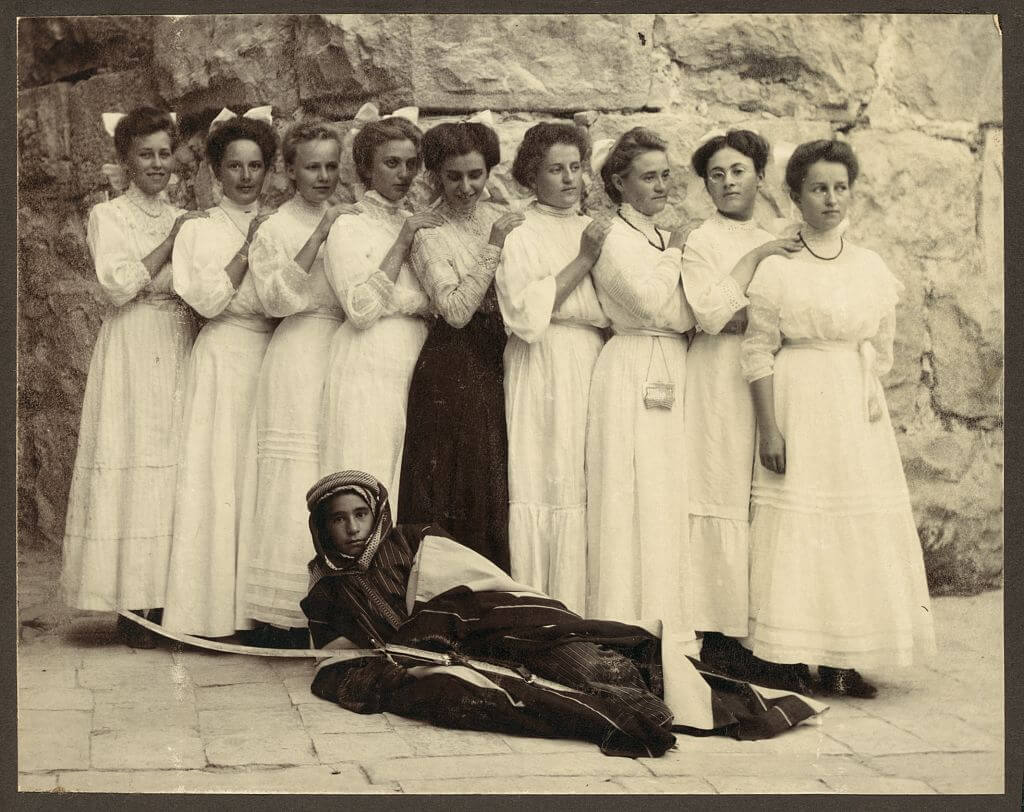
The American Colony’s expertise in photography started with one person, Elijah Meyers, an East Indian Jewish immigrant who converted to Christianity. Originally from Bombay, he was a photography enthusiast. Soon after joining the group, he established the American Colony Photo Department and began teaching photography to others in the Colony.
Many of their photos showed the activities and people of the American Colony, but it wasn’t long before they discovered the commercial value of their work, too. Already in October 1898, they were able to photograph Wilhelm II, the German Kaiser and King of Prussia, when he visited Jerusalem to dedicate a church with his wife. They were able to sell these photos to publishers in Europe, giving the Colony a nice financial boost.
Kaiser and Kaiserin lead royal cortege past the German Lutheran Church of the Redeemer, which they had come to Jerusalem to dedicate
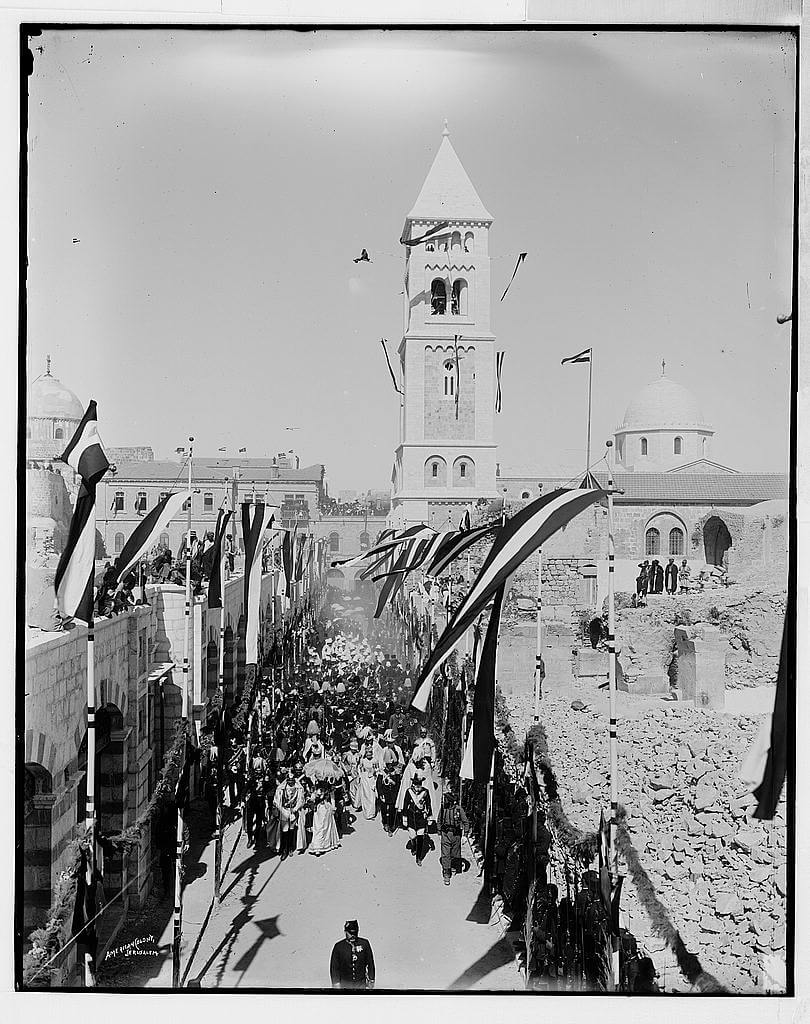
At that time, there were already several successful local photographers in Jerusalem. For example, Garabed Krikorian and Khalil Ra’ad were both prominent Palestinian photographers who ran portrait studios that were widely respected.
However, Krikorian and Ra’ad catered mainly to local residents, who wanted portraits of themselves in business suits or sophisticated clothing. The Colonist photographers were catering to a different set of clients: people in the West, especially Christian publishers and tourists.
As Barbara Bair points out in her interesting article about the American Colony Photo Department, this Western audience wanted something different than what local photographers were offering. Western tourists were interested in souvenirs, documentary photos, and quaint pictures that reflected biblical stories. They wanted historical clothing and picturesque desert landscapes, nothing modern or sophisticated.
Sinai. Sunrise from summit of Gebel Mousa
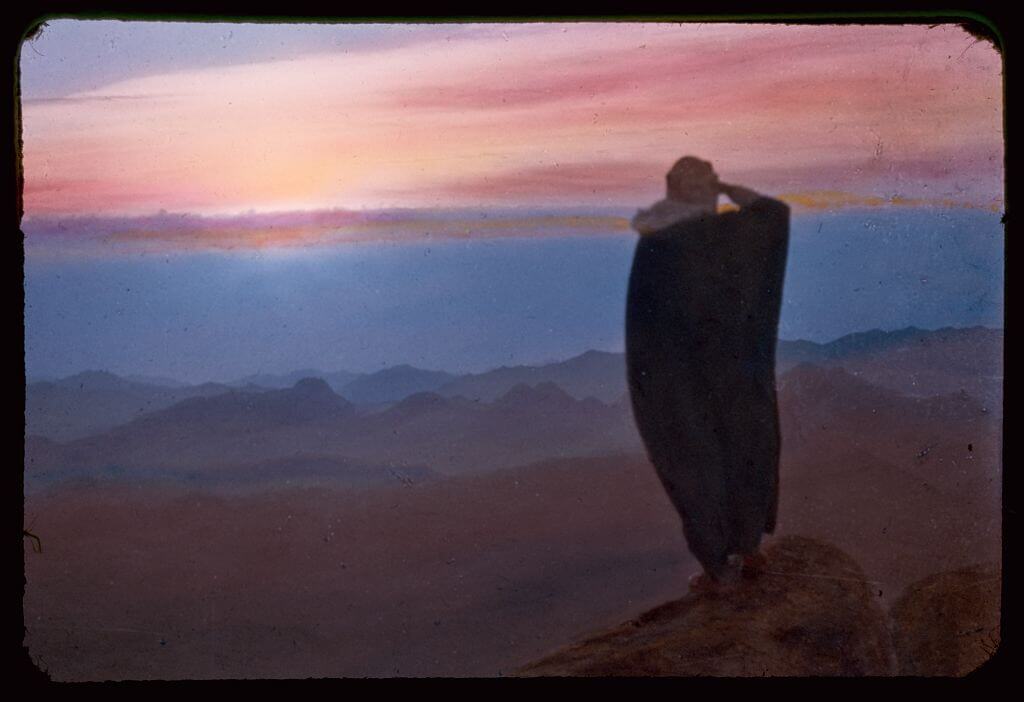
Egyptian camel transport passing over Olivet, 1918
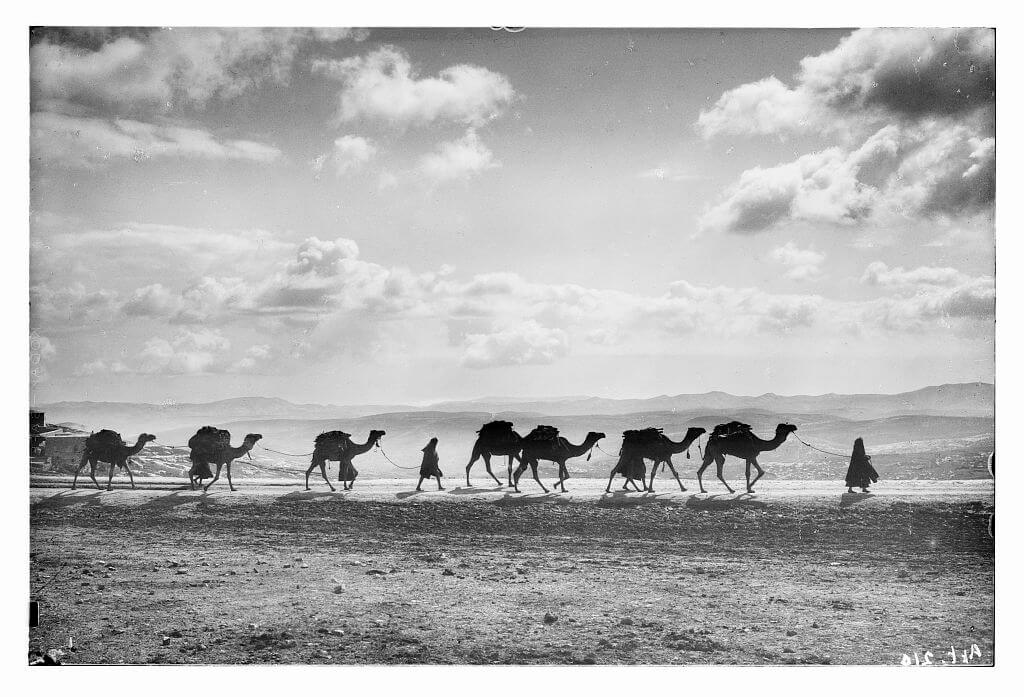
While some Palestinian photographers did produce Western-oriented postcards and documentary photos, those pictures were typically a side gig, not the foundation of their business. Seeing this niche in the market, the American Colony began to create photographs for Western clients.
Although the American Colony was mainly focused on charitable work, such as establishing hospitals and schools, they did need a source of income for their community. To earn this money, they had developed a shrewd business side, running a store with locally-produced goods and a hostel for tourists (which later became a boutique hotel, still popular today).
This store was the perfect place to sell images. Soon, the American Colony was producing hand-colored postcards, posters, stereographs, photo albums, and glass lantern slides specifically for Western tourists. They also did custom orders for book illustrations and personal travel albums, as well as offering photo tours for amateur photographers.
While photography wasn’t their main goal to begin with, it became a vital source of income for the Colony. This financial dependency on photography led to some tricky decisions, however. Sometimes, the Colonist photographers had to choose between authenticity and profitability, as the best-selling images were not always the most truthful.
The truth was, Western tourists often visited the Middle East with pictures already in mind. Rather than being open to everything, they wanted to see specific places and scenes they’d imagined. Then, they wanted to buy souvenirs of those scenes, real or not, to show their family and friends back home.
For example, Christian tourists wanted “images that were emblematic of New Testament scenarios (shepherds with their flocks, women at the well, women grinding grain, fishermen with their nets, the arched streets of the Via Dolorosa, the river Jordan).” If photographers provided those images, they could make a good profit in the tourism industry.
Set of thirteen select slides of shepherd life illustrating the Twenty-Third Psalm. “He leadeth me in paths of righteousness”
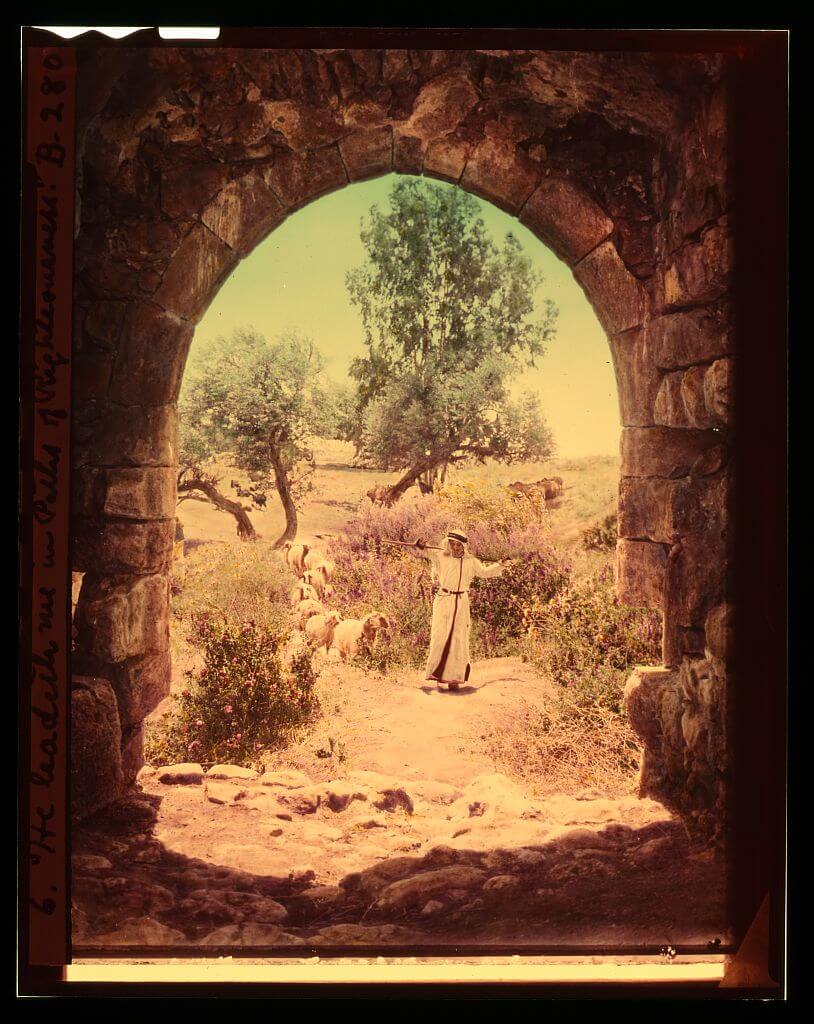
Shepherd scenes. Pastoral scene in the Jordan valley. Shepherd boy playing to his sheep
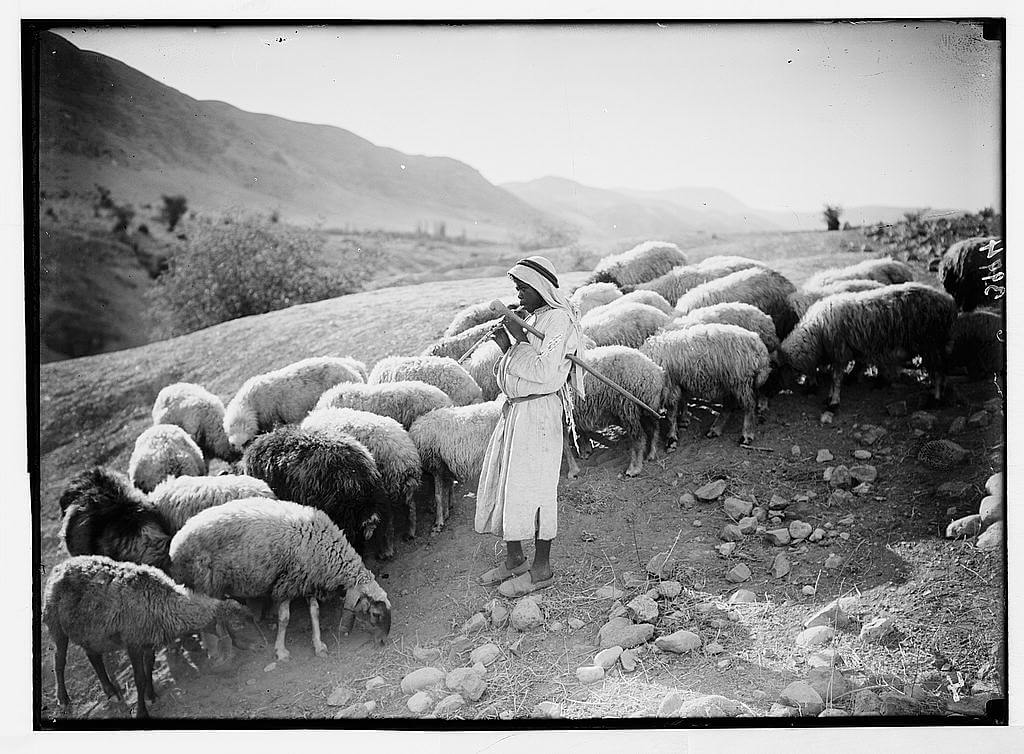
This was an ethical dilemma that all enterprising photographers in the Middle East had to deal with, even before the American Colony was established. There was a “tradition of photography of the Near East by westerners and for westerners,” which focused exclusively on certain subjects and locations. It wasn’t the full truth, but rather “a combination of fantasy, reality, documentation and desire.”
The American Colony photographers weren’t the first to create these “tableau” pictures for the West, but they were exceptionally good at it. “They excelled in this particular niche market, producing albums of gorgeous hand-tinted sepia photographs and pictorial prints of lush romantic Palestinian landscapes.”
Creating these somewhat artificial images was lucrative, but it did perpetuate stereotypes about the Middle East. The images made the area seem primitive, creating “a timeless arc from ancient times to the present.”
Yet selling these images did help the American Colony remain financially independent and continue their charitable work. It was a tough decision that professional photographers still struggle with today. Should you capture the full truth, or create images that will sell?
Usually, photographers find a middle ground between the two extremes of unpopular truth and profitable fantasy. For example, portrait photographers might choose the best angles and make flattering edits afterward, so their portraits will sell. Or photojournalists might have a sensational, sellable story in mind as they decide which subjects to photograph.
The American Colony eventually found a middle ground, too. When leadership of the photo department passed to Hol Lars (Lewis) Larsson, one of Meyer’s talented students, the Colony began to produce more documentary pictures of daily life in Jerusalem and in the desert among the bedouins.
These photos were accurate, yet also captured the imagination of Westerners. Especially among the bedouins, they could photograph traditions, scenes, and subjects that Westerners wanted to see, while still remaining close to reality.
Beersheba. Bedouin women ploughing, with a camel
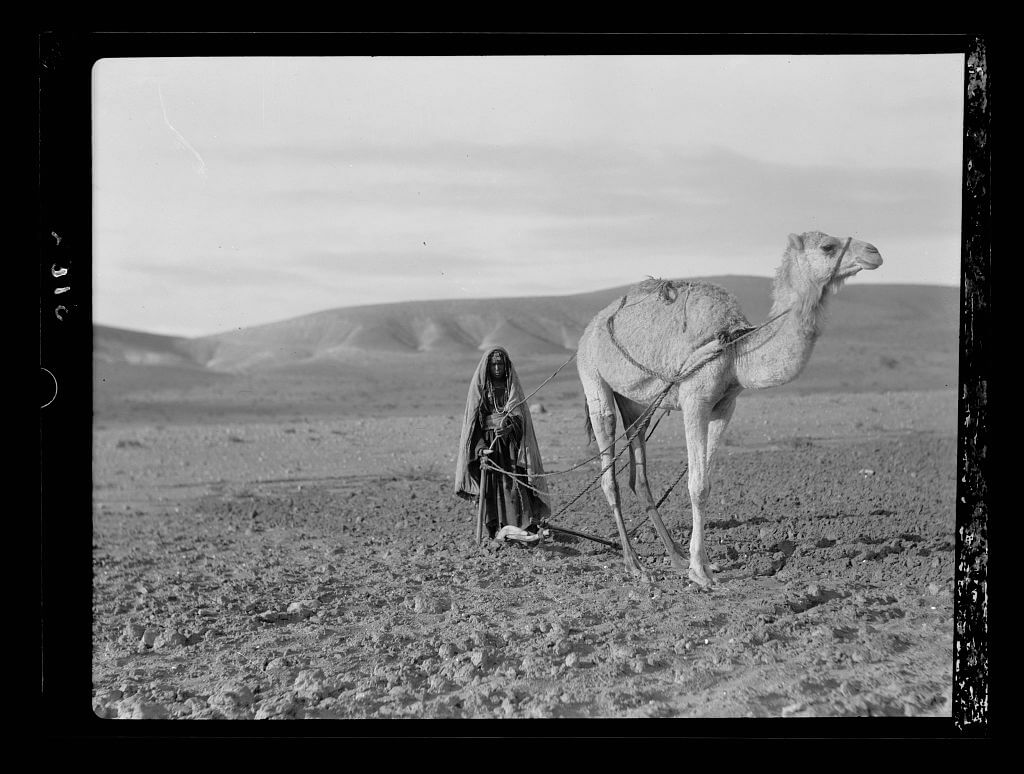
Bedouin life in Trans-Jordan. Bedouin woman and child on a camel. Snugly seated in a “khudduj”
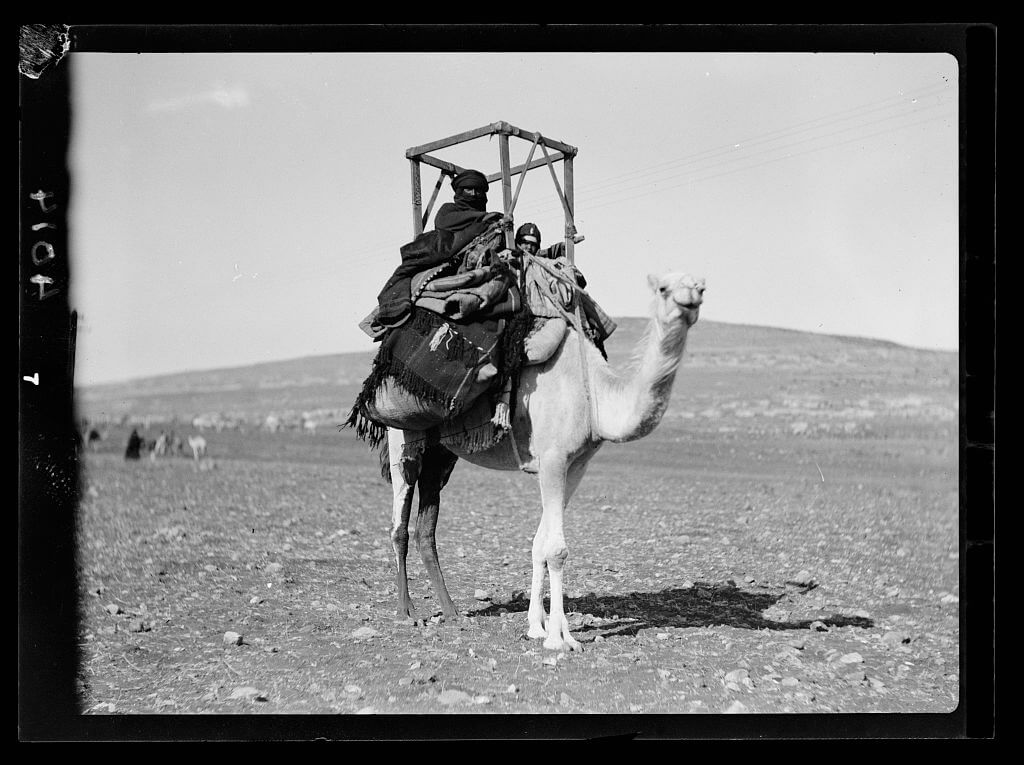
Larsson was naturally drawn to shooting these documentary photos. Besides being a skilled photographer, he was an excellent observer with deep knowledge of the region. He traveled a lot in the Middle East between 1903 and 1910, getting to know the land and its people. Later, he even served as Swedish Consul for Palestine.
The documentary photos he and other Colonist photographers took ended up being historically more important than the picturesque souvenirs so popular among tourists. “Though the Colony photo department was known for these aesthetic hand-tinted Holy Land interpretations, it was actually in the arena of photo-journalism and documentary photography that many of the most significant Colony images were made,” Bair writes.
For example, the Colonist photographers captured the locust plagues of 1915 and 1930, including “before” and “after” pictures of the Garden of Gethesmene devastated by locusts. They also captured images showing how the bedouins fought the locusts and celebrated once the plague was over.
Locust plagues in Palestine. Methods of fighting the locust plague. Tramping down a pit of locusts. A smelly job as shown by the labourers holding their noses
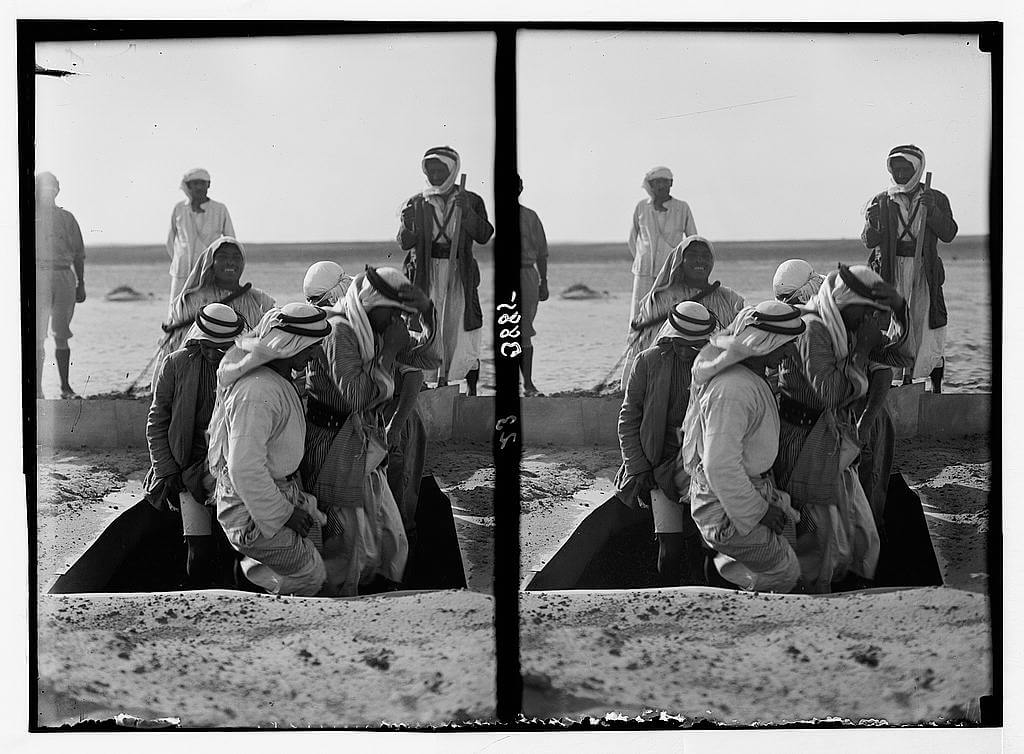
Locust plagues in Palestine. Methods of fighting the locust plague. Locust fighters preparing an evening meal on a fire made with camel dung

Close of the 1930 locust campaign. Bedouins racing and feasting at Beersheba on June 30th, 1930. Bedouins watching the races. Bedouins of the desert from far and near
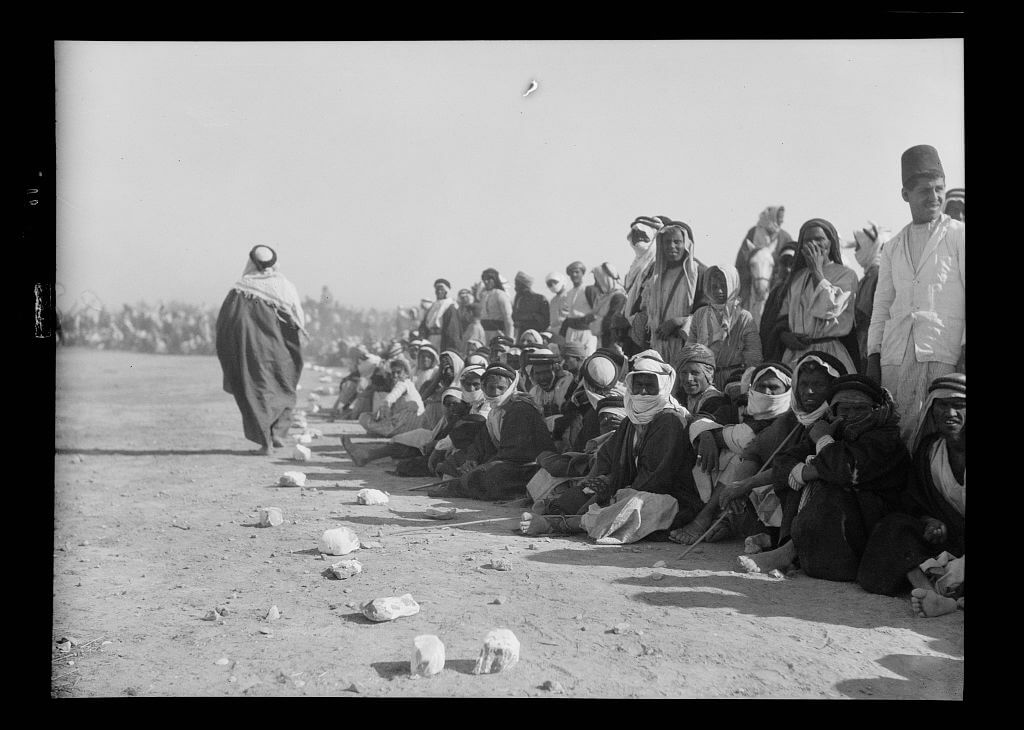
When World War I broke out, the Colonist photographers began to shoot not only scenes of daily life, but also scenes from the war and the collapse of the Ottoman empire. For instance, one of Larsson’s most famous pictures shows the mayor of Jerusalem, raising the white flag of surrender to the arriving British troops.
They also witnessed a lot of changes in the region, not just geopolitical, but also technological. For example, they photographed the challenges of introducing cars and airplanes to the desert. They documented new roads being built, as well as the people who built them.
To Sinai by car. Car stuck in the midst of a sand dune. Sand drifts across the road
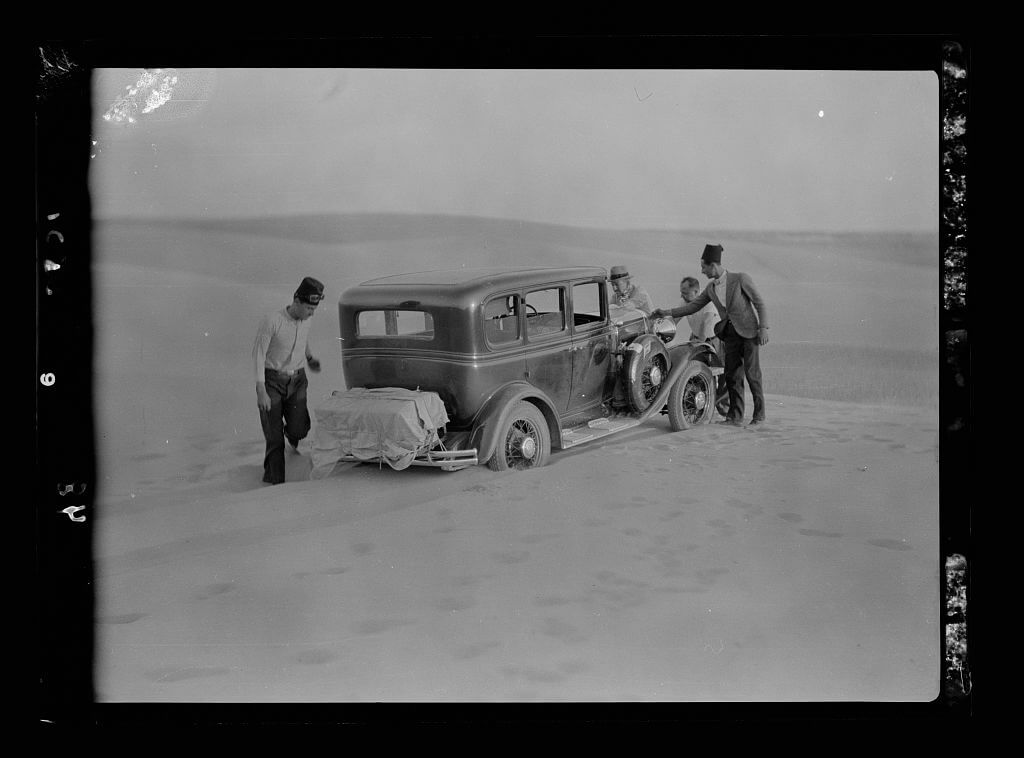
Bedouin life in Trans-Jordan. A road builder in Trans-Jordan

While the Colony’s photo department was thriving, the Colony itself was falling apart due to internal politics, especially between the Americans and Swedes. Initially, the Colony was kept together by its charismatic and domineering leader, Anna Spafford, who decided practically everything. After her death in 1923, the Colonists struggled to find harmony.
Most of all, they fought over who should control the future of the Colony and its store, which was highly profitable by then. It was a dramatic fight that started with tension and gossip, and ended with an ugly, expensive lawsuit. The conflict even attracted the attention of the American consul general and British officials, who arranged for a Crown prosecutor from Cairo to settle the case.
(You can read about this conflict in John Powers’s excellent paper: “Jerusalem’s American Colony and Its Photographic Legacy”.)
In the end, Larsson lost control of the photo department. In 1934, one of his assistants, G. Eric Matson, took over managing the department and its assets. Though a Swede himself, Matson was married to an American, Edith Yantiss, who worked in the department’s darkroom and specialized in hand-coloring prints.
This relationship united him with the American side of the conflict, giving him an advantage in the Colony’s internal politics. But besides that, he was an excellent photographer who introduced new techniques to the Colony, like aerial photography and 3-D pictures.
Matson photographing in Petra, 1934
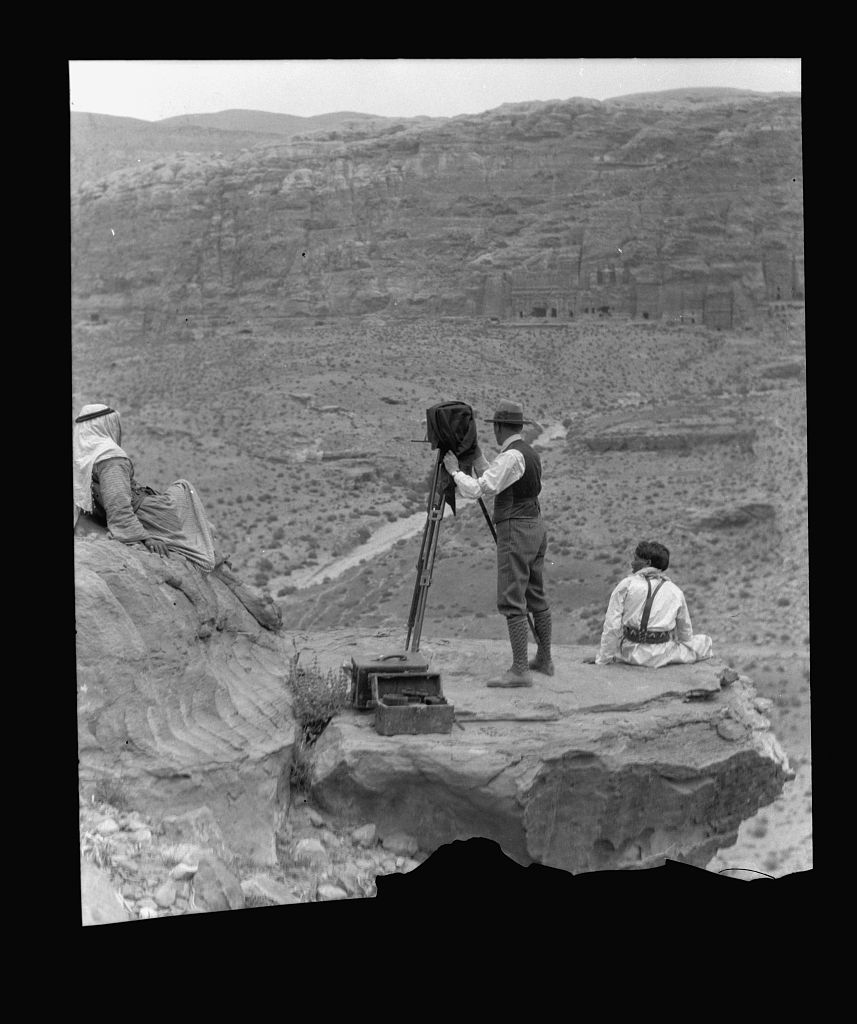
Matson was also a keen collaborator. Besides working with Palestinian photographers like Hanna Safieh and Joseph H. Giries, he often collaborated with John D. Whiting, a member of the Colony who was born in Jerusalem and spoke Arabic fluently.
In addition to writing for National Geographic, Whiting led regional tours for scholars, archaeologists, and British officials, which Matson would sometimes join. Then, after the trip, they’d prepare custom reprints for the people they had guided.
This collaboration continued even after the Colony broke up. In 1940, Matson and his wife renamed the photo department, calling it “The Matson Photo Service” instead. Under this name, they continued to gather new clients, focusing especially on newspaper, book, and magazine publishers.
A tribal lunch at cavalry post at Tel-el-Meleiha, 20 miles North of Beersheba, Jan. 18, 1940. Long line of Bedouin sheiks etc., seated under Reception tent of black goats hair
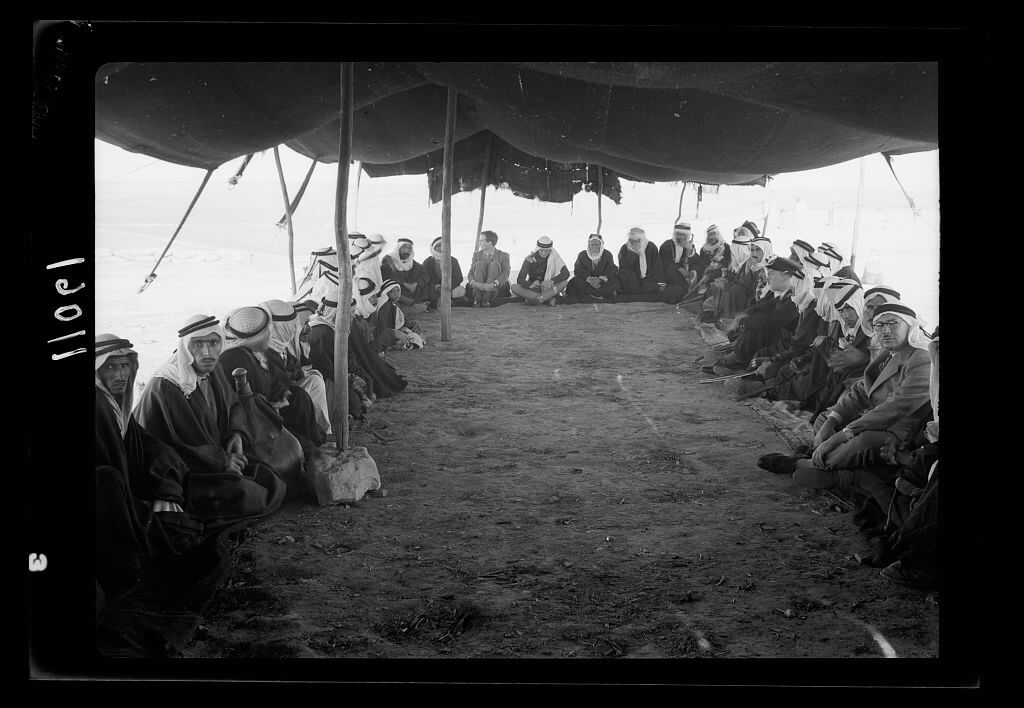
Unfortunately, political unrest and violence soon ended The Matson Photo Service. In 1946, just before the Palestine War, the Matsons left for California. Meanwhile, their Palestinian staff stayed to maintain the business through the war.
The store and office were heavily damaged during the war. However, the staff had managed to save the negatives by shipping most of them to the Matsons and storing the remaining stock in another part of Jerusalem.
After the war, tourism was so low that the Photo Service in Jerusalem was forced to close completely. Though the Matsons continued to sell photos from their home in California, they were unable to keep their photography staff in Jerusalem.
In 1964, Matson decided to donate the massive collection to the Library of Congress to best preserve it. The Library then arranged for the negatives in Jerusalem to be sent to Washington, D.C. These negatives had been stored in a damp YMCA basement in Jerusalem for many years. They had some water damage, but they were still intact.
Bedouin man playing the rababeh (a single string instrument) with a bow
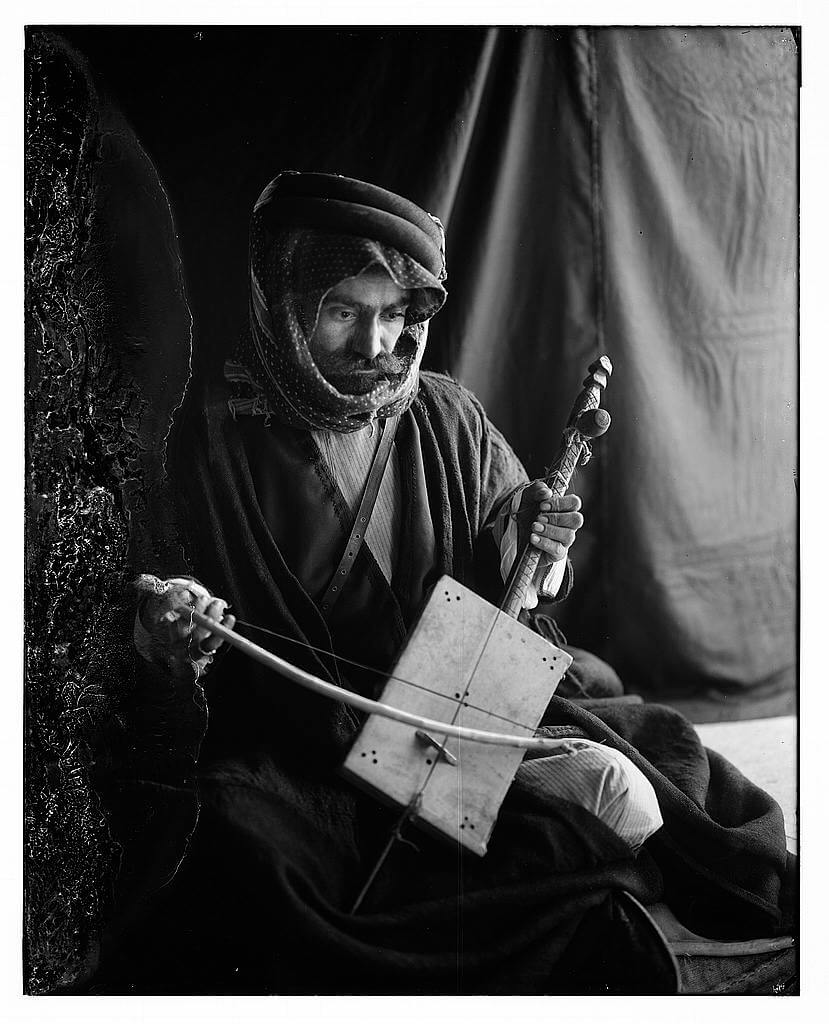
With Matson’s help, the Library of Congress staff worked to organize and identify the photographs. Though the complete stories behind the photos have been lost, the collection still has many beautiful shots from a unique time worth looking at.
The portraits of bedouins in the collection are especially interesting because they’re a mix of careful posing and candid expressions. Some of the portraits were clearly sold as postcards to tourists, but others are genuine moments, showing true emotions and scenes among the bedouins.
That being said, the line between authenticity and commercial photography is sometimes hard to distinguish. Did the photographer shoot these portraits for their audience (Westerners), their subject (bedouins), or their own interest? It’s an interesting question to ask while looking through this fascinating collection.
Historical Portraits of Bedouins
To see more photos from the American Colony Photo Department and The Matson Photo Service, view the full collection on the Library of Congress website.
To Sinai via the Red Sea, Tor, and Wady Hebran. Camel kiss; camel nibbling at his master’s nose
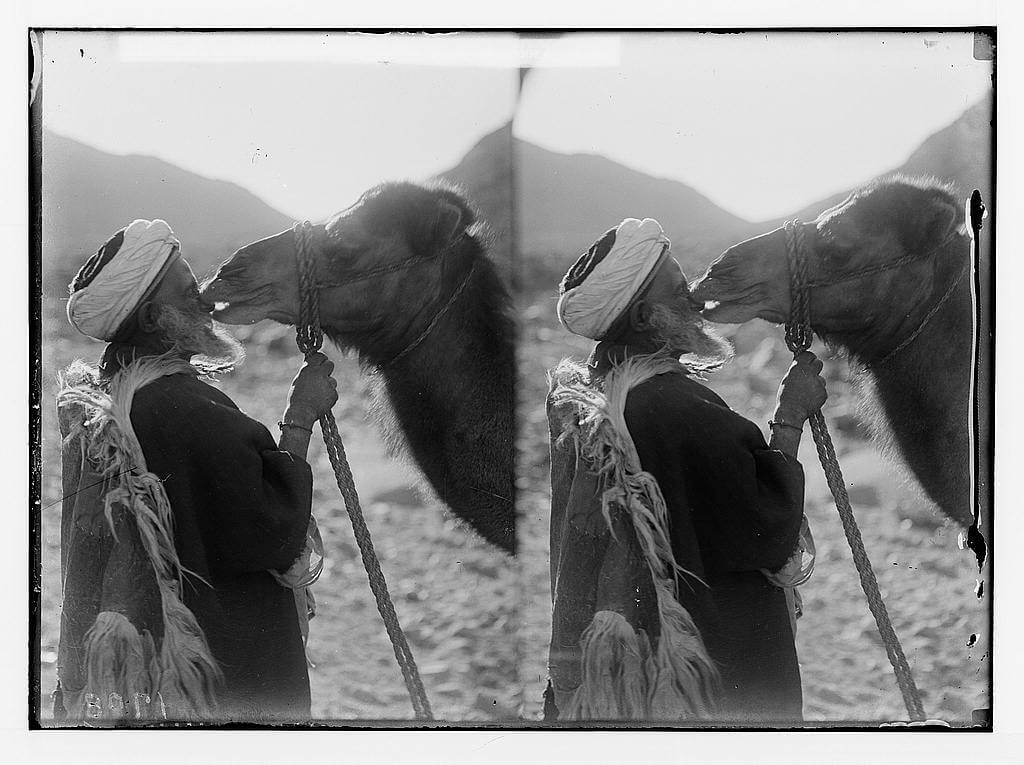
Excavations. Tell Jemmeh, (Gerar). Searching for relics. Earth carefully sifted for fragments
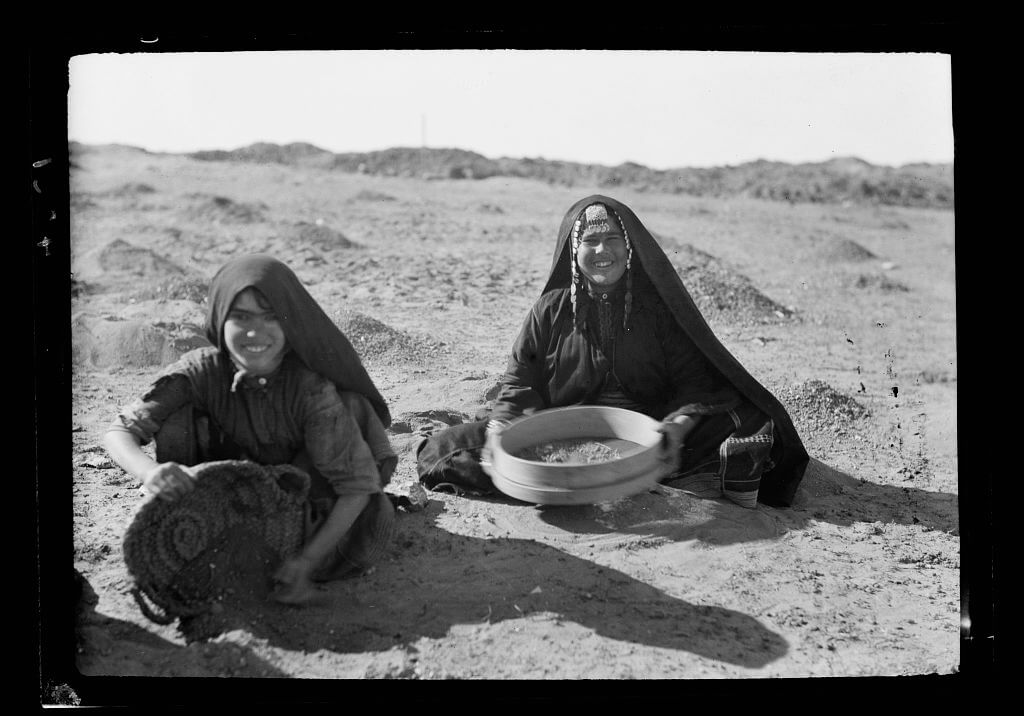
Young Bedouin man blowing (bagpipe) instrument
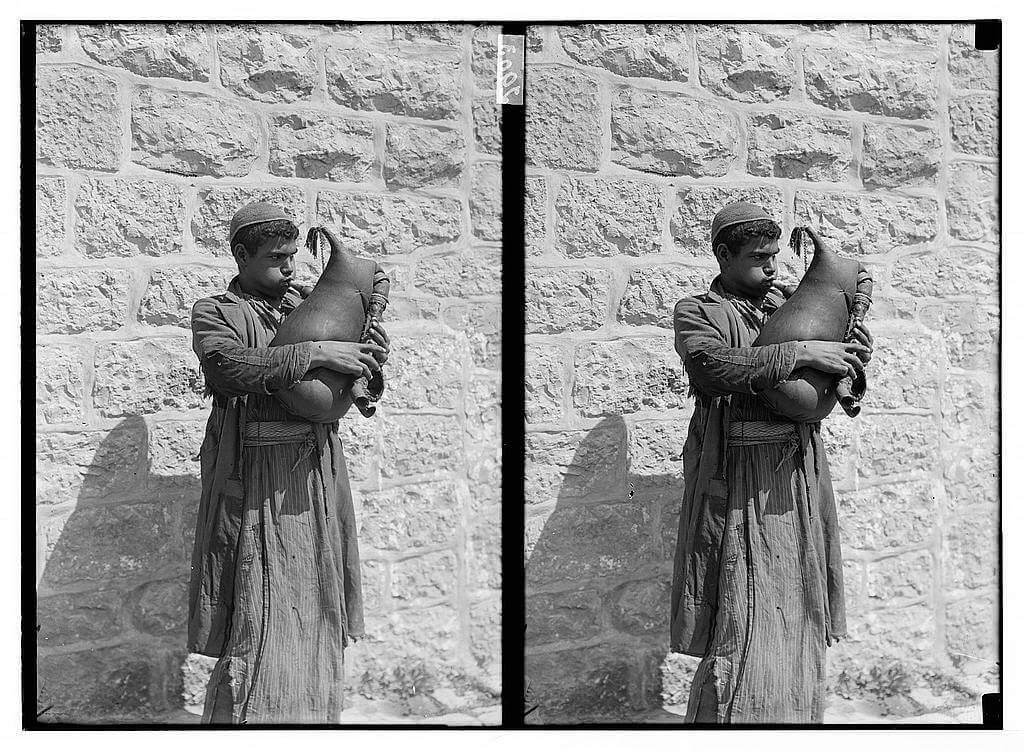
Bedouins, some at Shunet Nimrin, etc., April 25, ’35
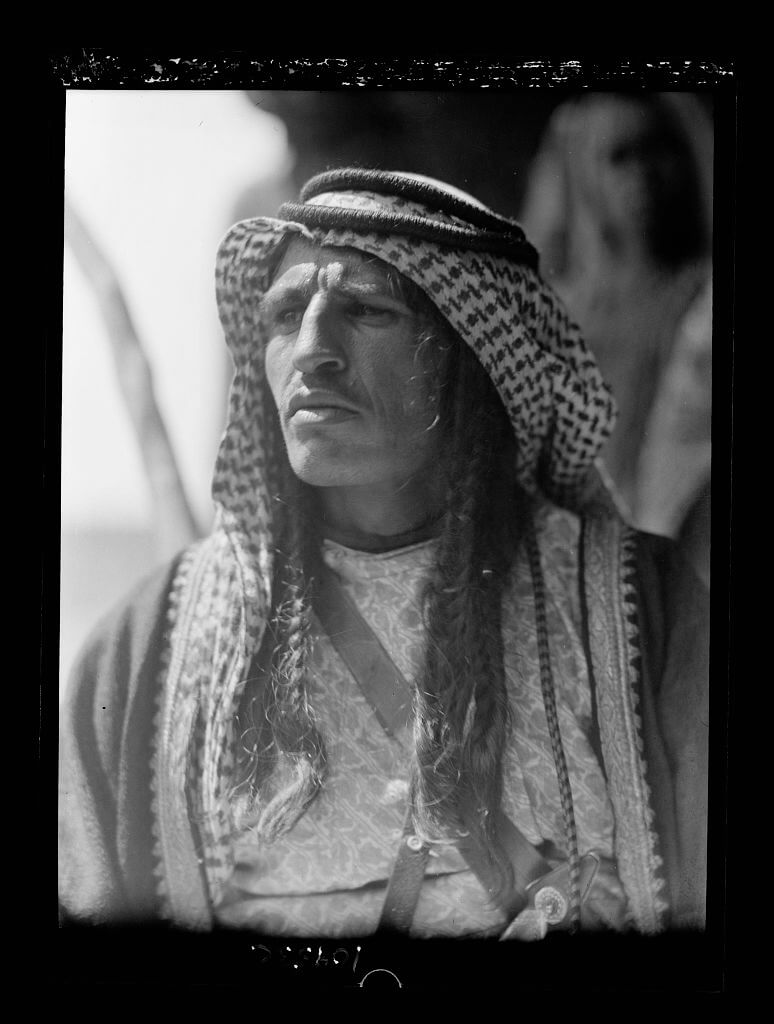
Petra. Bdul Bedouins. Performing an incantation over a sick man

Petra. Bdul Bedouins. Mother and baby before their cave home in ed-Dêr Valley
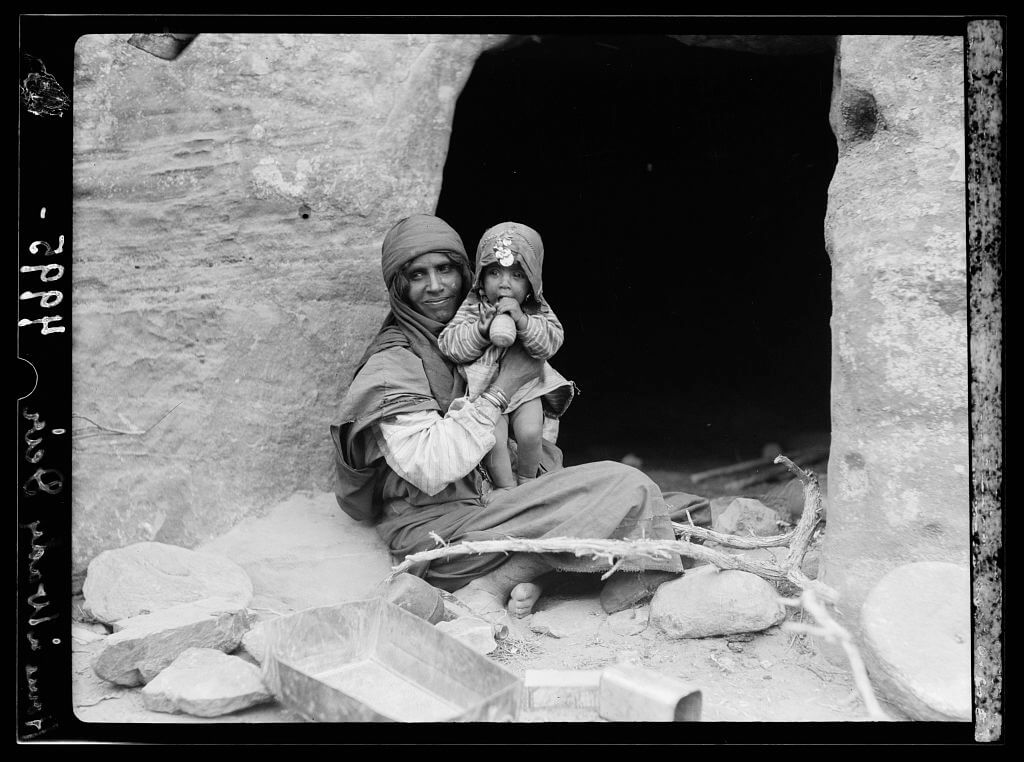
Bedouin girl in Tiberias with tatoo [i.e., tattoo] face

Bedouins eating around large tray in Shunet Nimrin
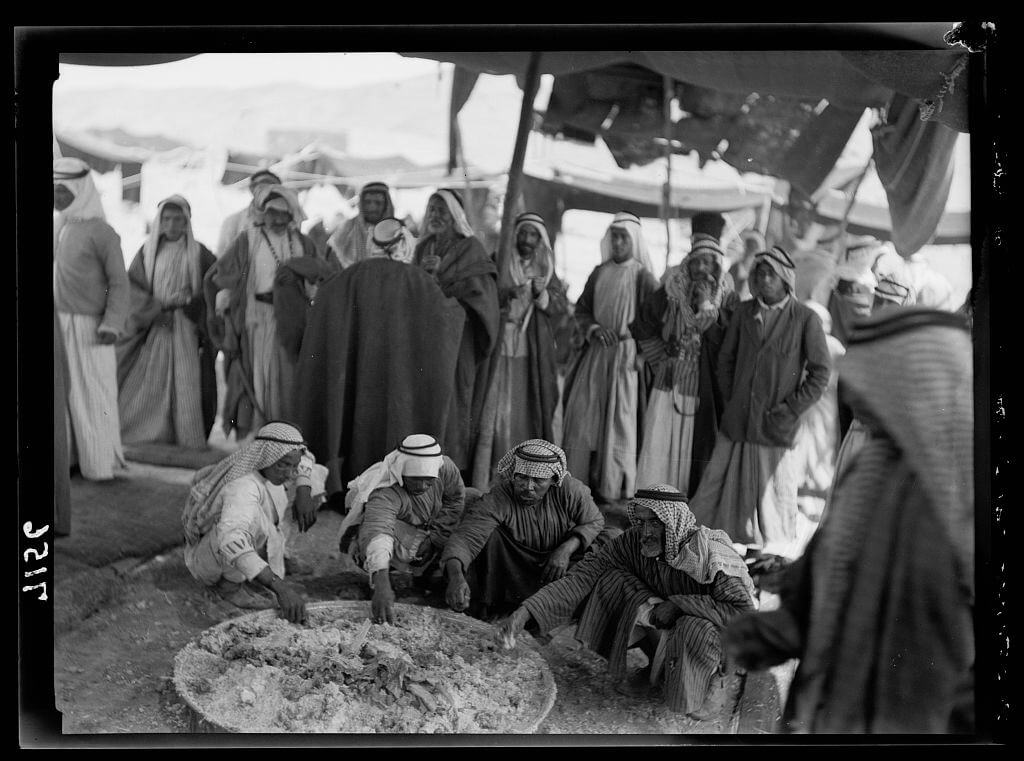
Woman weaving a straw mat. Semi Bedouin type in M’Keis, ancient Gadara
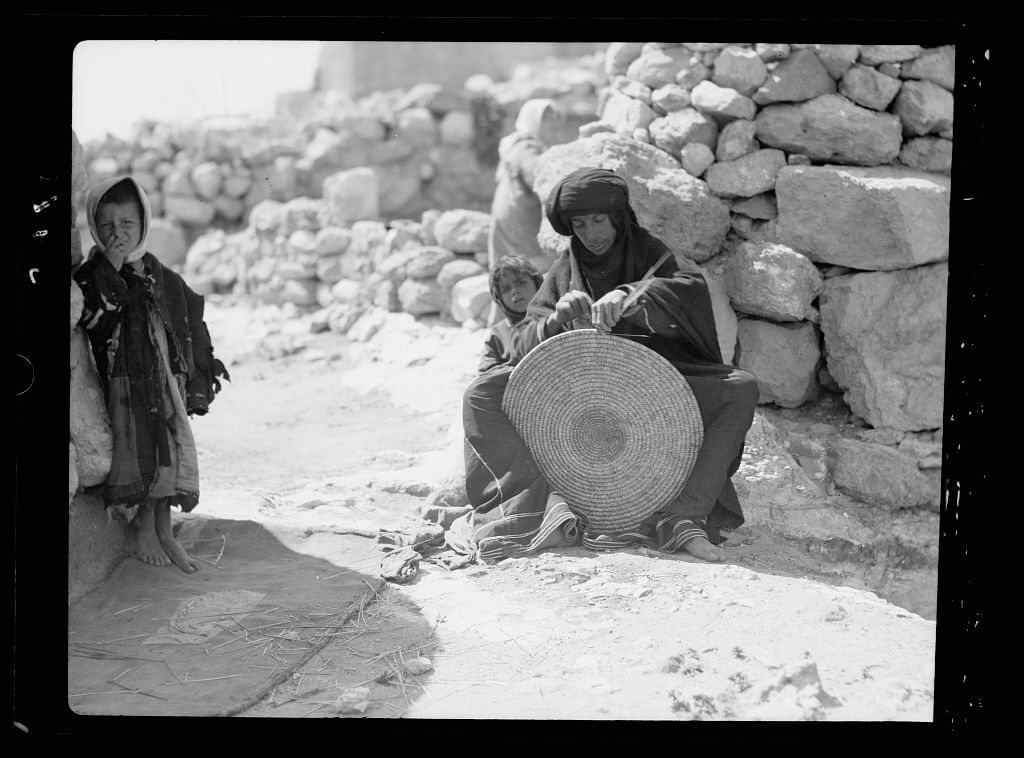
Bedouin wedding series. The bride
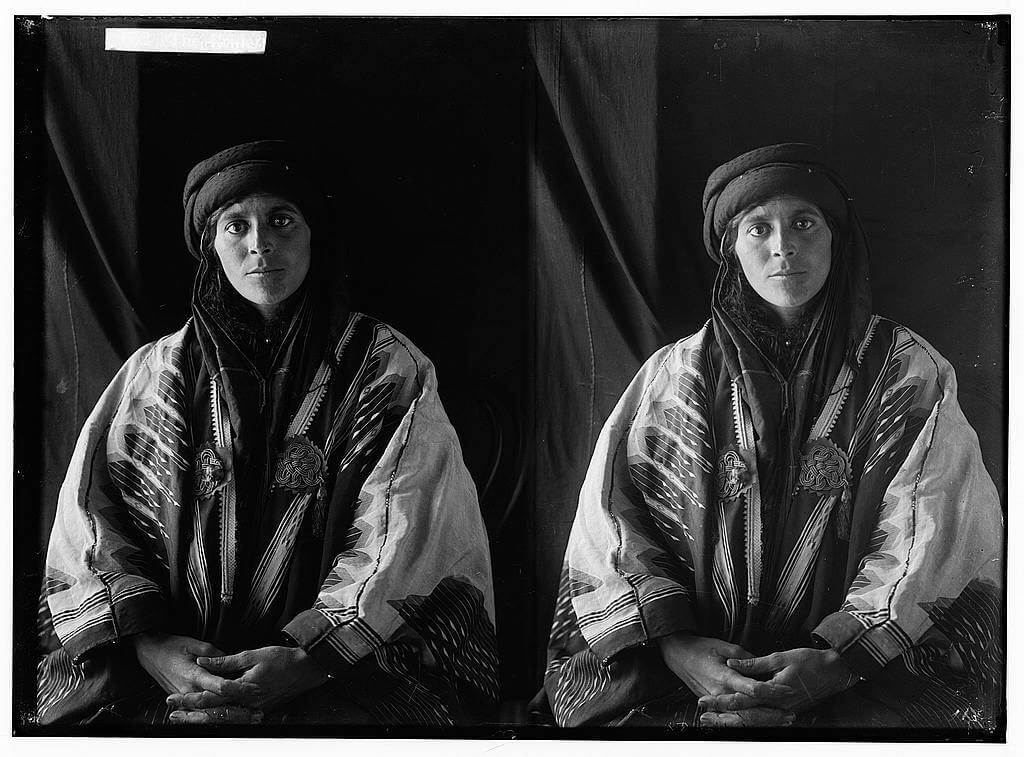
Bedouin wedding series. Jumping competition
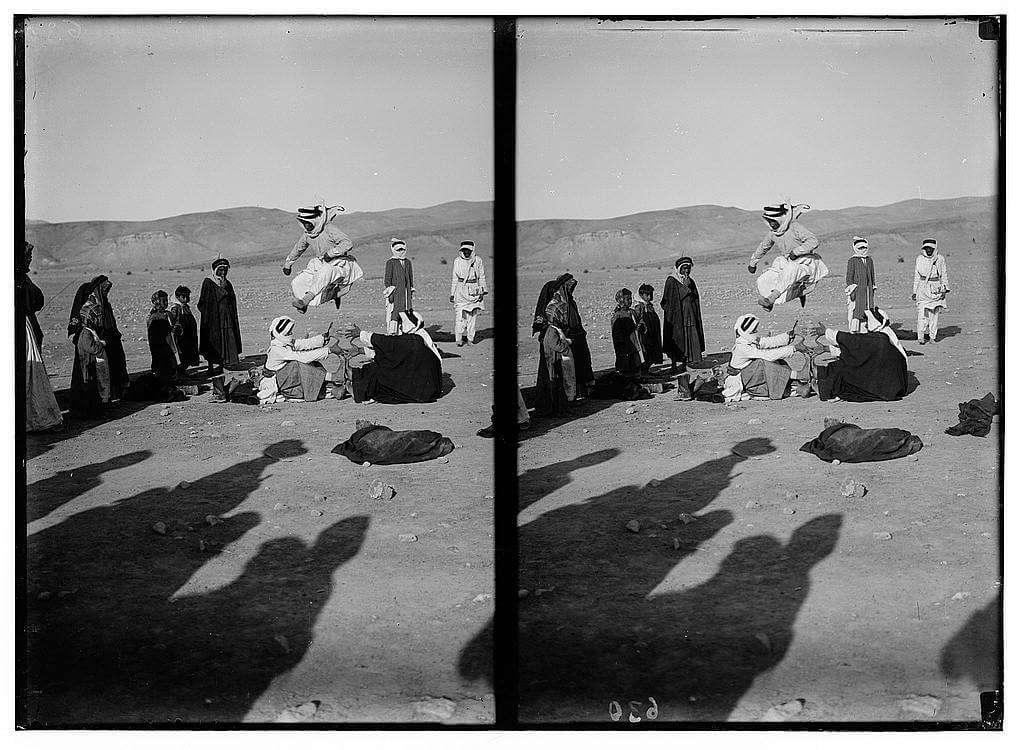
Bedouin wedding series. Playing “cat and mouse”
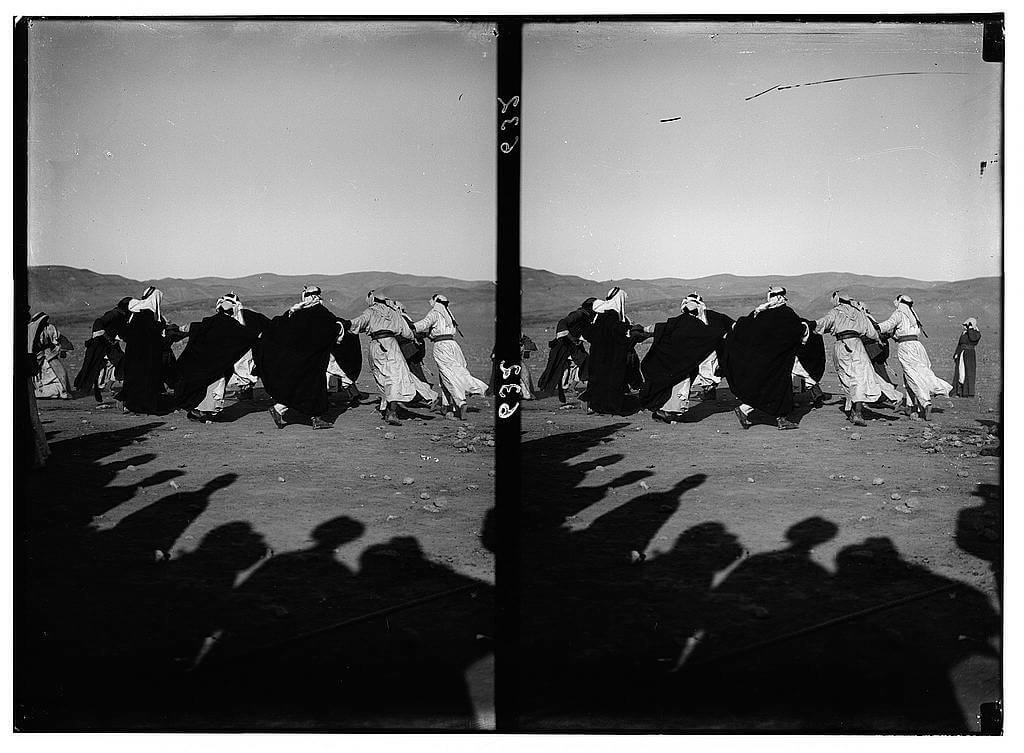
Bedouin life in Trans-Jordan. Bedouin greeting. Two men touching foreheads. The usual Bedouin salutation
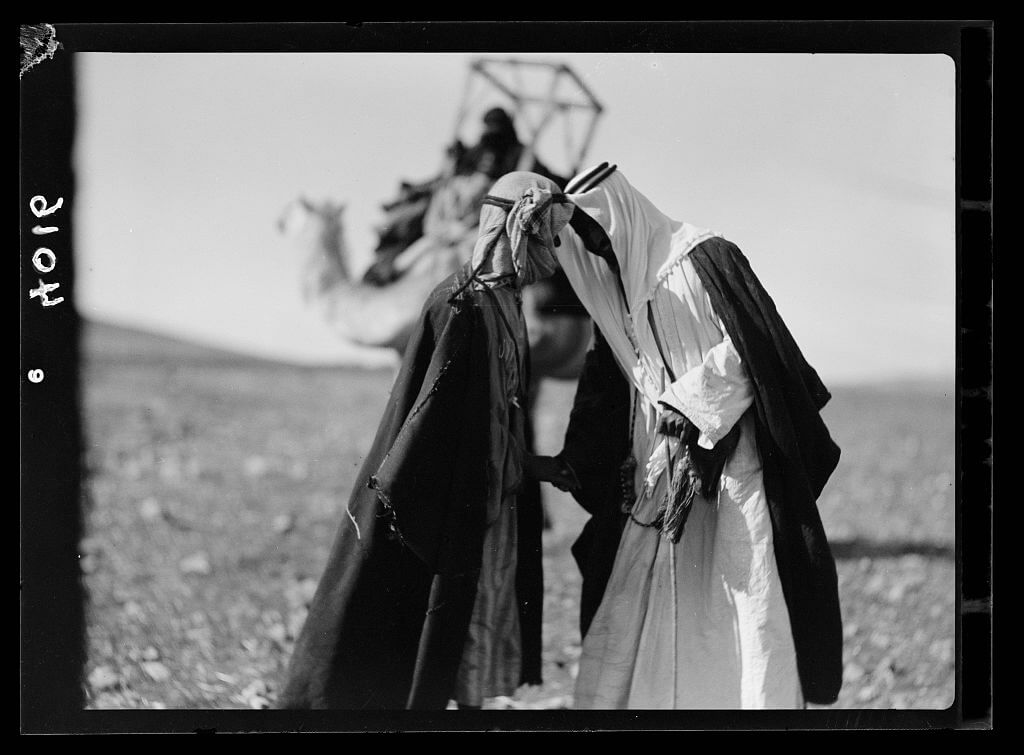
Scots Mission Hospital, Tiberias. Bedouin women at the clinic, waiting
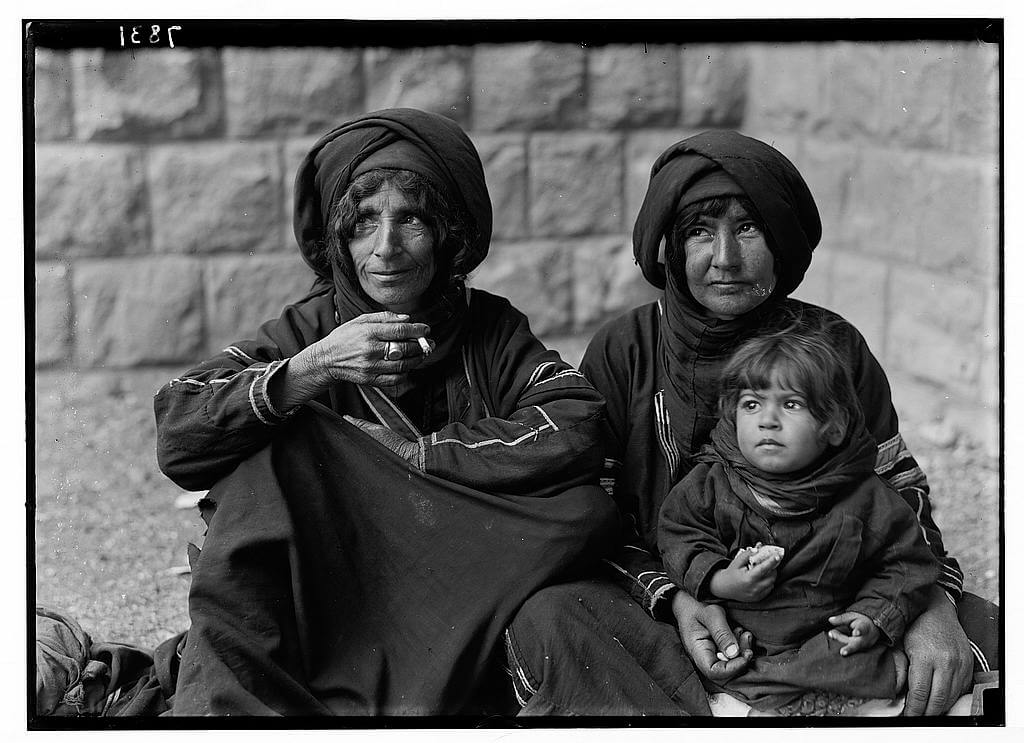
Christian Bedouin girl of Es-Salt, sitting in doorway, sewing
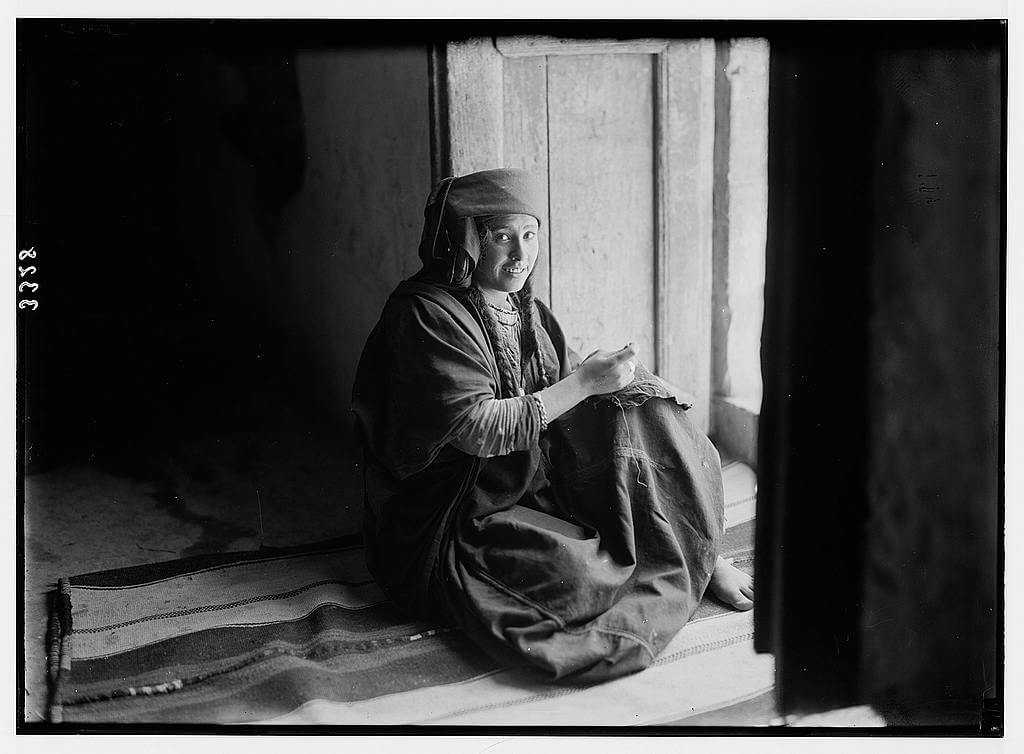
Aref el Aref & Bedouin sheikhs
